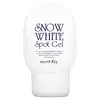What's inside
What's inside
 Key Ingredients
Key Ingredients

 Benefits
Benefits

 Concerns
Concerns

 Ingredients Side-by-side
Ingredients Side-by-side

Zea Mays Starch
AbsorbentPotassium Lauryl Sulfate
EmulsifyingCetearyl Alcohol
EmollientSodium Lauryl Sulfate
CleansingWater
Skin ConditioningHydrogenated Castor Oil
EmollientGlycerin
HumectantRhamnose
HumectantLactic Acid
BufferingPiroctone Olamine
PreservativeZinc Sulfate
AntimicrobialZinc PCA
HumectantPropanediol
SolventParaffinum Liquidum
EmollientCocamidopropyl Betaine
CleansingCI 77891
Cosmetic ColorantCI 77492
Cosmetic ColorantPotassium Phosphate
BufferingGlucose
HumectantGlucuronic Acid
BufferingParfum
MaskingZea Mays Starch, Potassium Lauryl Sulfate, Cetearyl Alcohol, Sodium Lauryl Sulfate, Water, Hydrogenated Castor Oil, Glycerin, Rhamnose, Lactic Acid, Piroctone Olamine, Zinc Sulfate, Zinc PCA, Propanediol, Paraffinum Liquidum, Cocamidopropyl Betaine, CI 77891, CI 77492, Potassium Phosphate, Glucose, Glucuronic Acid, Parfum
Water
Skin ConditioningButylene Glycol
HumectantNiacinamide
SmoothingPropanediol
SolventPEG-60 Hydrogenated Castor Oil
EmulsifyingTrehalose
HumectantCarbomer
Emulsion StabilisingCaprylyl Glycol
EmollientPotassium Hydroxide
BufferingEthylhexylglycerin
Skin ConditioningAloe Barbadensis Leaf Juice
Skin ConditioningAllantoin
Skin ConditioningDipotassium Glycyrrhizate
Humectant1,2-Hexanediol
Skin ConditioningTocopheryl Acetate
AntioxidantPrunus Amygdalus Dulcis Oil
Skin ConditioningSodium Hyaluronate
HumectantCentella Asiatica Extract
CleansingScutellaria Baicalensis Root Extract
AstringentPolygonum Cuspidatum Root Extract
AntioxidantGlycyrrhiza Glabra Root Extract
BleachingCamellia Sinensis Leaf Extract
AntimicrobialChamomilla Recutita Flower Extract
MaskingRosmarinus Officinalis Leaf Extract
AntimicrobialDisodium EDTA
Parfum
MaskingWater, Butylene Glycol, Niacinamide, Propanediol, PEG-60 Hydrogenated Castor Oil, Trehalose, Carbomer, Caprylyl Glycol, Potassium Hydroxide, Ethylhexylglycerin, Aloe Barbadensis Leaf Juice, Allantoin, Dipotassium Glycyrrhizate, 1,2-Hexanediol, Tocopheryl Acetate, Prunus Amygdalus Dulcis Oil, Sodium Hyaluronate, Centella Asiatica Extract, Scutellaria Baicalensis Root Extract, Polygonum Cuspidatum Root Extract, Glycyrrhiza Glabra Root Extract, Camellia Sinensis Leaf Extract, Chamomilla Recutita Flower Extract, Rosmarinus Officinalis Leaf Extract, Disodium EDTA, Parfum
Ingredients Explained
These ingredients are found in both products.
Ingredients higher up in an ingredient list are typically present in a larger amount.
Parfum is a catch-all term for an ingredient or more that is used to give a scent to products.
Also called "fragrance", this ingredient can be a blend of hundreds of chemicals or plant oils. This means every product with "fragrance" or "parfum" in the ingredients list is a different mixture.
For instance, Habanolide is a proprietary trade name for a specific aroma chemical. When used as a fragrance ingredient in cosmetics, most aroma chemicals fall under the broad labeling category of “FRAGRANCE” or “PARFUM” according to EU and US regulations.
The term 'parfum' or 'fragrance' is not regulated in many countries. In many cases, it is up to the brand to define this term.
For instance, many brands choose to label themselves as "fragrance-free" because they are not using synthetic fragrances. However, their products may still contain ingredients such as essential oils that are considered a fragrance by INCI standards.
One example is Calendula flower extract. Calendula is an essential oil that still imparts a scent or 'fragrance'.
Depending on the blend, the ingredients in the mixture can cause allergies and sensitivities on the skin. Some ingredients that are known EU allergens include linalool and citronellol.
Parfum can also be used to mask or cover an unpleasant scent.
The bottom line is: not all fragrances/parfum/ingredients are created equally. If you are worried about fragrances, we recommend taking a closer look at an ingredient. And of course, we always recommend speaking with a professional.
Learn more about ParfumPropanediol is an all-star ingredient. It softens, hydrates, and smooths the skin.
It’s often used to:
Propanediol is not likely to cause sensitivity and considered safe to use. It is derived from corn or petroleum with a clear color and no scent.
Learn more about PropanediolWater. It's the most common cosmetic ingredient of all. You'll usually see it at the top of ingredient lists, meaning that it makes up the largest part of the product.
So why is it so popular? Water most often acts as a solvent - this means that it helps dissolve other ingredients into the formulation.
You'll also recognize water as that liquid we all need to stay alive. If you see this, drink a glass of water. Stay hydrated!
Learn more about Water